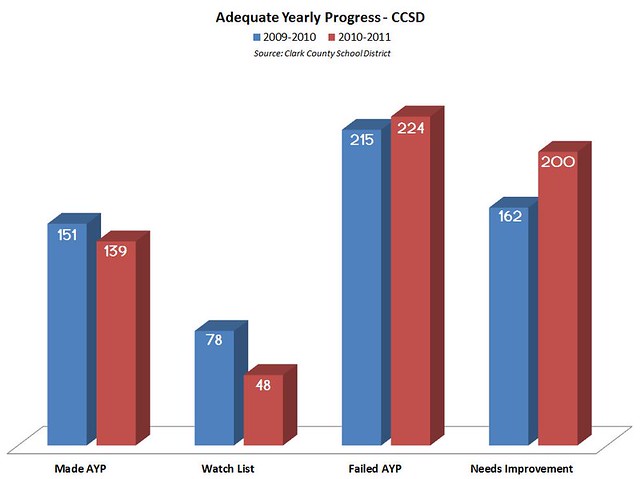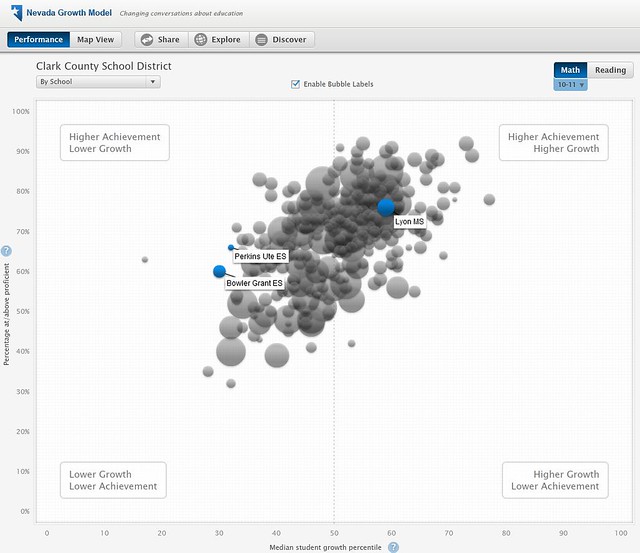By Whitney Donohue
Moapa Valley Progress
Two of the four schools in Moapa Valley did not make Adequate Yearly Progress (AYP) as measured by the federal No Child Left Behind standards. Grant M. Bowler Elementary and W. Mack Lyon Middle School both were classified as Needs Improvement.
Ute Perkins Elementary was classified as Meets Expectations. Moapa Valley High School was classified as a High Achievement school.
AYP standards measure student test scores overall for the school as well as in a variety of student sub-groups. The sub-groups include students in the general population, students with disabilities, students with limited English proficiency, and students qualifying for free or reduced lunch. AYP measures the progress of each sub-group before giving a designation to the whole school. If any of the sub-groups falls short of the standard, the school does not make AYP.
Both Lyon Middle School and Bowler Elementary actually showed significant gains in reading and math test scores. But because one or more sub-groups performed poorly, the entire school was classified as Needs Improvement.
AYP currently measures two areas as part of No Child Left Behind: proficiency of the students and the gap between where they are and where they are expected to be. The part that isn’t measured by AYP is the growth of the student. Most administrators feel this element is important to the overall picture of how the schools and students are doing.
In 2009-2010 Nevada brought a pilot program into the state called the Nevada Growth Model (NVGM). The Clark County School District has taken the reins of this program and, along with the Nevada Dept. of Education, has been developing it.
The NVGM measures a student’s progress from year to year, and compares the student to like students. This allows parents, teachers, and administrators to get a better understanding of how their student is actually improving.
“AYP gives kind of a skewed pictures of a school as a whole, because the schools are labeled as Needs Improvement if even one sub-group is not successful, even if all the other groups have made significant gains” said Mack Lyon Middle School principal Rod Adams. “The Nevada Growth Model is great for parents because it follows the individual kids, and compares them apples to apples.
“The model still has kinks that need to be worked out,” Adams added. “It is based on one test only, the CRTs, and if they change that test, it throws out all of our previous data.”
The NVGM does shed a different light on the schools that are participating (it is not yet available at the high school level). In both reading and math, the NVGM puts Mack Lyon in the High Achievement – High Growth quadrant, which is vastly different from the Needs Improvement label of AYP. This indicates that Mack Lyon students as a whole are doing quite well.
Paired with AYP, the NVGM is considered by many educators to be a better picture of the school’s successes, as well as the areas that need improvement.
Bowler Elementary also fares better on the Nevada Growth Model. The school is classified as High Achievement – Low Growth on reading and math. This quadrant suggests that the majority of students are doing well in the standardized testing. However the growth of those students hasn’t been as significant as it has for those schools in the High Achievement – High Growth quadrant.
Bowler principal Shawna Jessen is hopeful that the NVGM will help fill in the gaps that AYP leaves.
“We’re still in the process of learning how [NVGM] will work with our kids,” Jessen said. “What we have to do is use the tools we have to promote growth. The gaps portion of AYP is a non-equitable system. It is really hard to compare students who have professionally-diagnosed learning problems to children without those problems. That’s what we like about this (NVGM) model – it allows us to compare like kids – not exactly apple to apple, but pretty close.”
“We’re a good school working to be a great school,” Jessen added.
Ute Perkins also fares well on the Nevada Growth Model, falling in the High Achievement – Low Growth quadrant along with Bowler Elementary. This reinforces the fact that the school does deserve its Meets Expectations AYP designation, with no sub-groups failing to meet standards.
David Bobzien, Chair of the Nevada Assembly Education Committee, agrees. “In theory, the Nevada Growth Model makes a lot of sense,” he explains. “We are still faced with the problem of how you measure a teacher’s contribution to education when a child is tested. I think the direction we’re going is the right direction, but I don’t think we’ve worked out all the problems yet.”
The NVGM comes at a time when school districts across the nation are struggling to keep up with ever-more restrictive No Child Left Behind Standards.
White House Education Secretary Arne Duncan recently announced that the government would allow states to “opt-out” of the law if they submit a better plan to improve their schools’ performances. The waiver is good for as long as Congress remains gridlocked over how best to reauthorize the government’s operational law governing elementary and secondary education, which is looking like it won’t be addressed until at least the election next year.
Bobzien doesn’t see the NVGM as a replacement for No Child Left Behind, but he believes that it is a good complement to the law as it exists in its current form.
The current school year marks the second year the NVGM has been implemented across the district, however it is being implemented in school districts across the state.
More information on the Nevada Growth Model can be found at http://ngma.doe.nv.gov/app/public/index.htm.








